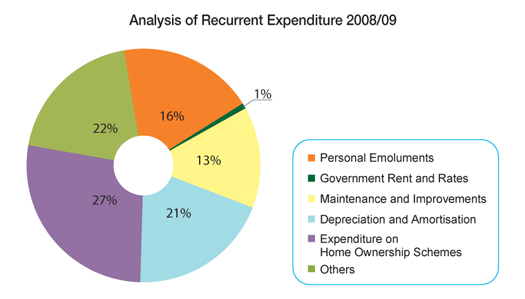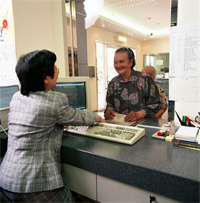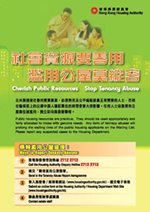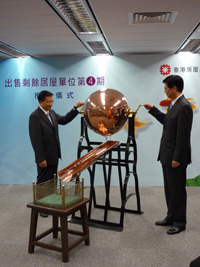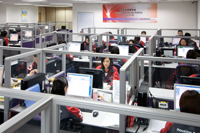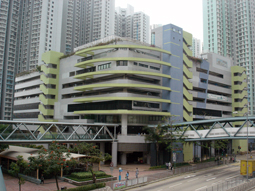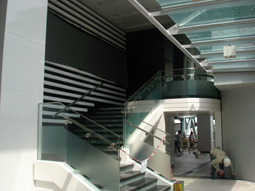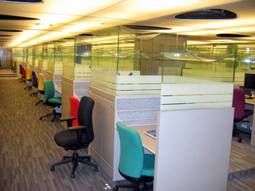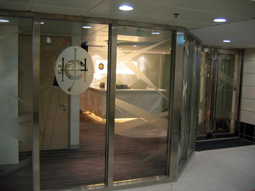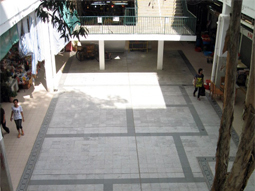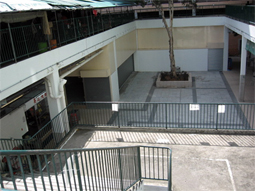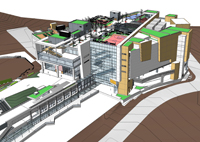Our Economic Performance
2008/09 was a difficult year in the wake of the dramatic financial tsunami. We implemented a series of measures to alleviate financial difficulties experienced by our stakeholders including the contractors and tenants. The measures included reduction of on-demand bonds from 10% to 3% in foundation and new works building contracts, the early payment of insurance premiums, shortening the payment period from 21 days to 14 days, additional interim payments between monthly payments for new works contracts, and new interim payments for estate works orders for maintenance work. These initiatives were introduced in the spirit of partnership and collaboration that we shared with our contractors.
During the year, the programme for several projects was also advanced in response to the government's call for the creation of job opportunities in view of the financial tsunami and the resulting economic downturn in 2008/09. These included the Demolition of Kwun Tong Flatted Factory, the construction of the Amenities and Community Building at Tin Shui Wai Area 104, and the integrated contract for the Design and Construction of Kai Tak Site 1B.
To ensure the sustainable economic performance of HA, especially during the economic downturn, we have made the best use of materials and the latest building techniques for achieving functional and cost-effective construction solutions, while enhancing quality, safety and living environment for our residents.
| Economic Performance Targets for 2008/09 | Progress |
|---|---|
| Implementing the new rent adjustment mechanism and following up the outcome of the Review of Domestic Rent Policy | Fully Met |
| Continue to minimise the vacancy of Public Rental Housing (PRH) estates. | Fully Met |
| Conduct tenancy control and education campaigns with an aim to reduce abuse of housing resources. | Fully Met |
| Continue on assessment of older estates and enhance their preventive maintenance, restoration and improvement. | Fully Met |
Financial Performance
HA is financially autonomous. Our massive public housing programmes are sustained through internally generated funds. A financial review for 2008/09 is provided in our Annual Report.
Overview of our financial performance
Consolidated Income Statement for the year ended 31 March 2009
| HK$ M | |
|---|---|
| Consolidated Operating Account Surplus | 4 111 |
| Funds Management Account Deficit | (4 007) |
| Agency Account Deficit | (7) |
| Surplus for the Year | 97 |
Breakdown of Consolidated Operating Account Surplus in 2008/09
| HK$ M | |
|---|---|
| Rental Housing Operations Deficit | (1 146) |
| Commercial Operations Surplus before exceptional items | 536 |
| Home Ownership Assistance Operations Surplus before exceptional items | 4 711 |
| Surplus for the year before special income and exceptional items | 4 101 |
| Add: Special income | 12 |
| Less: Exceptional items | (2) |
| Consolidated Operating Account Surplus for the Year | 4 111 |
Capital Expenditure for the fiscal years 2004/05 - 2008/09
| Items | HK$ M | |||||
|---|---|---|---|---|---|---|
| 2004/05 | 2005/06 | 2006/07 | 2007/08 | 2008/09 | ||
| Construction | 7 228 | 3 467 | 3 634 | 4 950 | 5 845 | |
| Improvement Works | 174 | 214 | 107 | 162 | 249 | |
| Computer Systems | 105 | 84 | 111 | 117 | 107 | |
| Total Capital Expenditure | 7 507 | 3 765 | 3 852 | 5 229 | 6 201 | |
As of 31 March 2009, the HA's funds available for investment stood at HK$56 375 million, an increase by HK$828 million as compared against 31 March 2008.
Housing Rent Policy
Rent Adjustment
On 1 January 2008, we introduced a new rent adjustment mechanism for PRH. Replacing the statutory 10% median-rent-to-income ratio cap, the new mechanism enables rent adjustments according to changes in tenants' household income. This new rent policy, which seeks to match rents more closely to tenants' affordability, better meets our objective to provide PRH for those in genuine need, thus promoting the long-term sustainability of our PRH programme.
Under the new rent adjustment mechanism, a review of PRH rents will be conducted in every two years. The first review will take place in 2010. The rate of rent adjustment for PRH will be determined by the rate of change in the income index, subject to a ceiling of 10% for rent increase.
During the year, under the government's inflation mitigation measures to support the disadvantaged in Hong Kong, rent-paying families in PRH, except those who are paying additional rents, did not have to pay rent for three months from August to October 2008, with the government bearing these costs. In addition, all tenants were able to benefit from our arrangements to pass the government's rates concessions on to them for the entire 2008/09 year.
Rent Assistance
Introduced in 1992, our Rent Assistance Scheme (RAS) continues to help PRH tenants suffering from temporary financial hardships. Under the scheme, recipients are able to obtain a rent reduction of either 25% or 50%, depending on their circumstances. The scheme has been reviewed from time to time and the eligibility criteria have been relaxed, making the scheme more readily available to tenants who need the assistance. There were 11 960 families paying reduced rents under the RAS as at the end of March 2009.
Rent Concession
As a quick response to the outbreak of the global financial tsunami since September 2008, we offered rent relief to retail and factory tenants. A concession in rental at 50% of the net rent, excluding rates and air-conditioning charges, was given to retail and factory tenants for the 2-month period from January to February 2009. For factory tenants, flexible approach has also been adopted on top of the existing rent review mechanism for renewing fixed term tenancies.
Resource Optimisation
It is our fundamental role to provide Public Rental Housing (PRH) to those who cannot afford housing in the private rental market. In 2008/09, around 25 000 flats were allocated to Waiting List (WL) applicants, with an average waiting time of 1.8 years for general applicants and 1.2 years for elderly one-person applicants.
| Average Waiting Time for PRH | ||
|---|---|---|
| Our Target | Actual Waiting Time | |
| General Applicants | 3 years | 1.8 years |
| Elderly One-person Applicants | 2 years | 1.2 years |
Reducing Vacancy Rates
With an aim to boost the acceptance rate of less popular flats and maximise the use of our housing resources, we have launched the 13th Express Flat Allocation Scheme (EFAS) in July 2008. Under this initiative, eligible applicants applying for PRH estates will have two opportunities to choose a housing unit. A total of some 2 110 families, including 50 families from the 12th EFAS exercise, were allocated flats by the end of March 2009.
To further reduce the vacancy rates of our housing resources, we also offer incentives to applicants who are willing to move into flats with relatively long vacancy periods. Applicants moving into flats that have been vacant for 12-24 months or over 24 months enjoy 50% reduction for eight months or 12 months respectively. In 2008/09, 2 160 flats were let out under such arrangement, among which 1 210 flats were let through EFAS.
Combating Tenancy Abuse
To eliminate abuse of public housing resources, we therefore established the Public Housing Resources Management Sub-section to keep a close watch on suspected cases of tenancy abuse, carrying out investigations and in-depth enquires if warranted.
Over 6 800 investigation cases of suspected tenancy abuse were conducted during the year. The sub-section also checked the declaration record of another 5 700 cases or so to determine tenant eligibility for subsidised housing. Their efforts are supported by preventive measures taken by the District Tenancy Management Office - the biennial inspections of public housing flats, for example, together with their day-to-day management duties and tenancy knowledge. These joint efforts, together with the voluntary surrender of flats due to other reasons, resulted in the recovery of PRH units in the year for re-allocation to needy families.
The root cause of tenancy abuse is tenant's attitude, and we saw education as the fundamental approach to prevent future cases. Publicity programmes like posters, leaflets, video and community outreach activities were thus organised to promote the value and benefits of public housing, reminding tenants to cherish public housing resources.
Tackling Rent Arrears
To prevent and combat rent arrears of our PRH and commercial tenants, we believe making it easier for tenants to pay their rents and to pay them on time is the best approach. Under this principle, we have launched several initiatives:
- Alternative Counter Collection Channels (ACCC) allowing tenants to pay their rents at over 900 convenience stores and more than 50 Customer Service Centres at MTR Stations;
- Direct transfer of rent allowances for Comprehensive Social Security Assistance households from the Social Welfare Department to the HA; and
- Publicity programmes encouraging tenants to give ACCC a try.
Since our expanding rent collection networks, we have seen a steady and encouraging decrease in rent arrears. The rate of rental arrears fell from 3.5% to below 3% during the year.
The previous rent enquiry hotline service has also been expanded with the establishment of internet services in December 2008. Tenants can now check their current rent status and their six-month rent payment history online. In addition, 100 Rent Enquiry Kiosks have been installed by March 2009, enabling tenants to check their rents payable and, if required, to print a rent enquiry advice slip for payment.
Disposal of Surplus HOS
With the repositioning of the government's public housing policies in 2002, we ceased the production and sale of Home Ownership Scheme (HOS) flats. With a stock of 16 700 HOS flats on hand, we commenced a programme to sell these surplus flats in an orderly manner from 2007 onwards.
| Phase | Commencement Period | Surplus HOS Flats Offered for Sale | HOS Flats Sold | Percentage of HOS Flats Sold |
|---|---|---|---|---|
| Phase 1 | January 2007 | 3 056 | 3 052 | 99.87% |
| Phase 2 | August 2007 | 3 255 | 3 255 | 100% |
| Phase 3 | February 2008 | 3 052 | 3 018 | 98.89% |
| Phase 4 | September 2008 | 3 221 | 1 900 | 58.99% |
The first three phases of this programme were very well-received by the public with sale rates near 100%, resulting in a total of 9 325 flats being sold. However, due to the global economic crisis and the uncertain outlook in the local economy starting from the fourth quarter of 2008, the fourth sales exercise recorded only 1 900 out of the 3 221 flats (about 59%) offered for sale were sold by the end of the sales period. Considering the sales result of the fourth sales exercise and the market conditions, we have decided to put about 1 400 flats on sale under the fifth sales exercise in the fourth quarter of 2009. We will also be keeping a close watch on market conditions when formulating future sales programmes for our residual stock.
During the sales of surplus HOS flats, the sales literature has been prepared in compliance with internal and external guidelines, including Circular Memorandums issued by the Legal Advisory and Conveyancing Office of the Lands Department; guidelines issued by the Real Estate Developers Association of Hong Kong; reports issued by the Law Reform Commission of Hong Kong and publications issued by other relevant parties.
Operation with Cost-Effectiveness
Even with the highest levels of social and environmental sustainability, our housing programme would not be sustainable if we do not sustain economically, through both functional and cost-effective design.
Cost Effective Design
Taking into account the site constraints and the optimal utilization of development potential, non-standard site specific domestic buildings have been built since 2000. A library of "Modular flat design" was drawn up in 2008 from the experience of building these diverse building developments in recent years. The modular flats aim to achieve an optimum design in the best interest of residents, less environmental impact, as well as greater efficiency and productivity through wider use of mechanised building process.
According to building tenders received in February/March 2009 and cost consultant reports, construction costs for our superstructures were in general some 36% lower than similar projects in the private sector. With a new software introduced to optimise the structural design of our buildings, it is hoped that this figure will improve even further.
Procurement
The HA's procurement strategy reached an important milestone this year. To make the best use of external resources for innovative design and technology advancement while at the same time maintaining our necessary quality controls, we launched a new Integrated Procurement Approach for the PRH development at Kai Tak Site 1B. This new mode serves to integrate innovative ideas in design and production, research, wider use of mechanized building process to realize the concept of sustainable development.
Ensuring Building Quality through Independent Checking Unit (ICU)
As our buildings do not fall under the control of the Buildings Ordinance, the Independent Checking Unit (ICU) provides third party monitoring and control of all existing and new HA developments and alteration works which operates in line with the Building Department's practices. Reporting directly to the Director of Housing, the ICU receives support and guidance from the Director of Buildings as well. ICU is also responsible for other duties to ensure building quality including:
- Under delegated authority from the Director of Buildings, responsible for exercising the Building Authority's powers over former HA buildings under the Home Ownership Scheme and Tenants Purchase Scheme as well as the commercial facilities now owned and managed by The Link REIT.
- Regulate the use of all lift and escalator installations within our estates in line with the Lifts and Escalators (Safety) Ordinance.
Total Maintenance Scheme (TMS)
Instead of passively reacting to a complaint or an enquiry regarding maintenance, we have established a proactive approach - TMS, which set up a cycle of maintenance and refurbishment for all PRH estates. Our In-flat Inspection Ambassadors visit flats to check if repairs are necessary. Minor repairing are carried out on the spot while works orders are issued immediately for more serious problems. Aiming to complete the inspection of all PRH estates within a five-year period, our ambassadors have visited some 188 400 flats, with an access rate of 85%, in 102 estates since the Scheme's inception in February 2006. Repairs have also been completed in 51 estates with 147 950 repair work items at a cost of HK$293 million.
A computerised TMS System (TMSS) supports this scheme, not only maintaining accurate maintenance records and maintenance histories of individual flats, but also helping with the issuing and processing of works orders as well as scheduling of appointments and repair works. Our ambassadors can have real-time access to this information while conducting inspection through the use of Personal Digital Assistants (PDAs). Tenants can make inspection appointments, check maintenance progress and provide comments and feedbacks on TMS through our maintenance hotline.
Promoting awareness and the value of the TMS to our tenants, the Maintenance Education Path in Tai Wo Hau Estate as well as Mobile Maintenance Education Booths which have been staged in 74 estates so far have attracted a total of 21 600 interested visitors. Customers' satisfaction surveys reflected that the TMS is well recognised by our tenants. With the introduction of the Scheme, the overall satisfaction for repair and maintenance services significantly increased from 40% to 86% (households whose maintenance works had been completed by October 2008). At the same time, 73% of these households felt that TMS was "very effective" or "effective" on improving the standard of our in-flat maintenance works. Building on the momentum of these positive responses, we have extended the TMS system to a permanent scheme that will cover other aspects of our maintenance and improvement activities.
Comprehensive Structural Investigation Programme
With the synergy of the TMS and our Comprehensive Structural Investigation Programme (CSIP) as well as the Estate Improvement Programme (EIP), we can maintain the quality of our estates, increase the life-span, and ultimately ensure the sustainability of our housing stock.
The CSIP focuses on the structural safety, the cost of repairs and the quality of accommodation provided by estates that are over or approaching 40 years old. During the year, investigations of Wah Fu Estate and Ping Shek Estate were completed, leading to the decision to extend the lifespan of these two developments for a further period of 15 years. Necessary repairs and improvements will be made in conjunction with the EIP, which seeks to revitalise our older buildings while strengthen community bonding within the estate. At Ping Shek Estate, for example, improvements will include the installation of lifts, which are currently not available, in the low-rise blocks.
In the coming year, we will be looking into the sustainability of four other estates - Mei Tung, Kwai Shing West, Lek Yuen and Oi Man Estates. Over the next decade, the CSIP will investigate a further 32 ageing estates.
Market-oriented Letting Strategies
Most of our retail premises are let at market rents through open tenders and direct negotiations. Aiming to boost our letting rates in relation to less popular shops and spaces, short-term letting strategies such as Open Instant Tenders, Walk-in Applications and the designation of vacant shops for multiple trades are also accepted. The trade mix of our premises undergoes regular reviews and new trades are introduced in line with market trends.
To ensure competitiveness and cost-effectiveness in the management and leasing of our retail premises, we have also employed specialist consultants to provide professional advices.
Maximizing usage of commercial premises
In addition to enhancing the retail potential of our commercial premises, we also explore measures to maximise the usage of less popular spaces for the benefit of the community. Successful lettings have been achieved through rearrangement of commercial premises.
| Locations | Initiatives | Status |
|---|---|---|
| Tin Heng Car Park | Renovation on the first, second and fifth floors to a Telebet cum Volunteers and Training Centre | Close to complete, to be opened in April 2009 |
| Nam Shan Market | Re-ordering of some market stalls to a larger shop for agricultural and fisheries products | Completed |
| Siu Hong Court | Convert market stalls to a food catering centre of some 244 m2 | Completed |
| Fu Shan Market | Market stalls converted into a single shop | Completed |
We are also devoted to the provision of welfare facilities for the community. During the year, 6 290 m2 of additional spaces were transformed into neighbourhood centres, day care centres, residential care homes for the elderly, social outreach offices, youth centres, as well as counselling centres.
At the same time, we enhanced the business environment and improved the retail potential of our estates through extensive renovation works, ranging from facelifts and better lighting, more attractive shop-fronts and ceilings, to improvements of toilets and air-conditioning systems.
The Best Use of IT
We continued to make significant investments in IT to further streamline our operations; to enhance our service efficiency and to provide more convenient services to our residents.
In October 2008, we marked a new era in our IT operations with the release of the new web-based Non-Domestic Management System, which ended the use of mainframe computers in our operations. The launch of internet services during the year was another significant achievement with its provision of both better and more convenient services for tenants. The use of these services by tenants has been growing steadily and further web-enabled functions will empower both our business growth and our customer engagement.
In recent years, new enabling technologies, such as facial recognition, use of 3D computer aided design, PDAs, imaging and mobile devices have provided the IT solutions and new ways to conduct and streamline our operations. The implementation of the Mobile Application System for Housing Management (MASHM) since 2008 replaces the previous paper-based Biennial Declaration made for PRH tenants. This practice can greatly save the time and effort of our staff. This application was also honoured a bronze award in the Best Public Service Application (Transformation) category of the Hong Kong ICT Awards 2008.
To improve efficiency and enhance security, estate management and imaging systems improvement has been completed to automate tenant applications with regard to changes in household members and temporary stays. This use of imaging technology in tenancy management can also reduce paper consumption significantly.
















